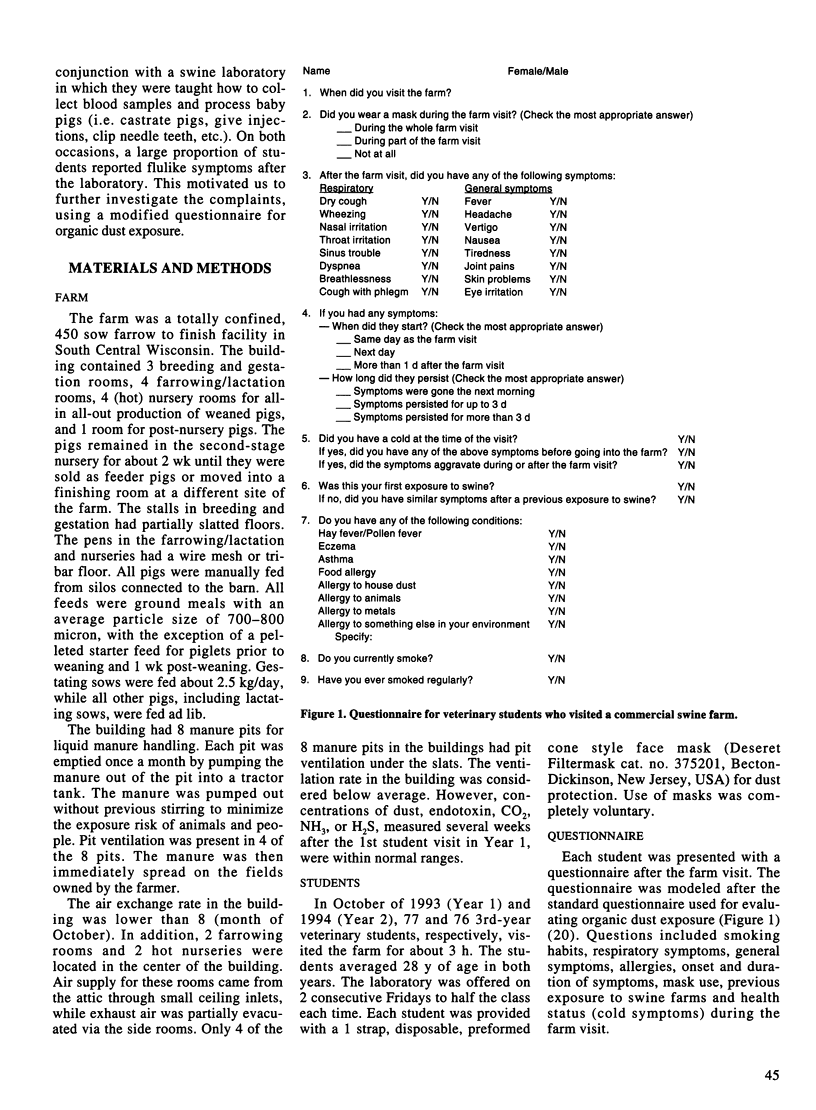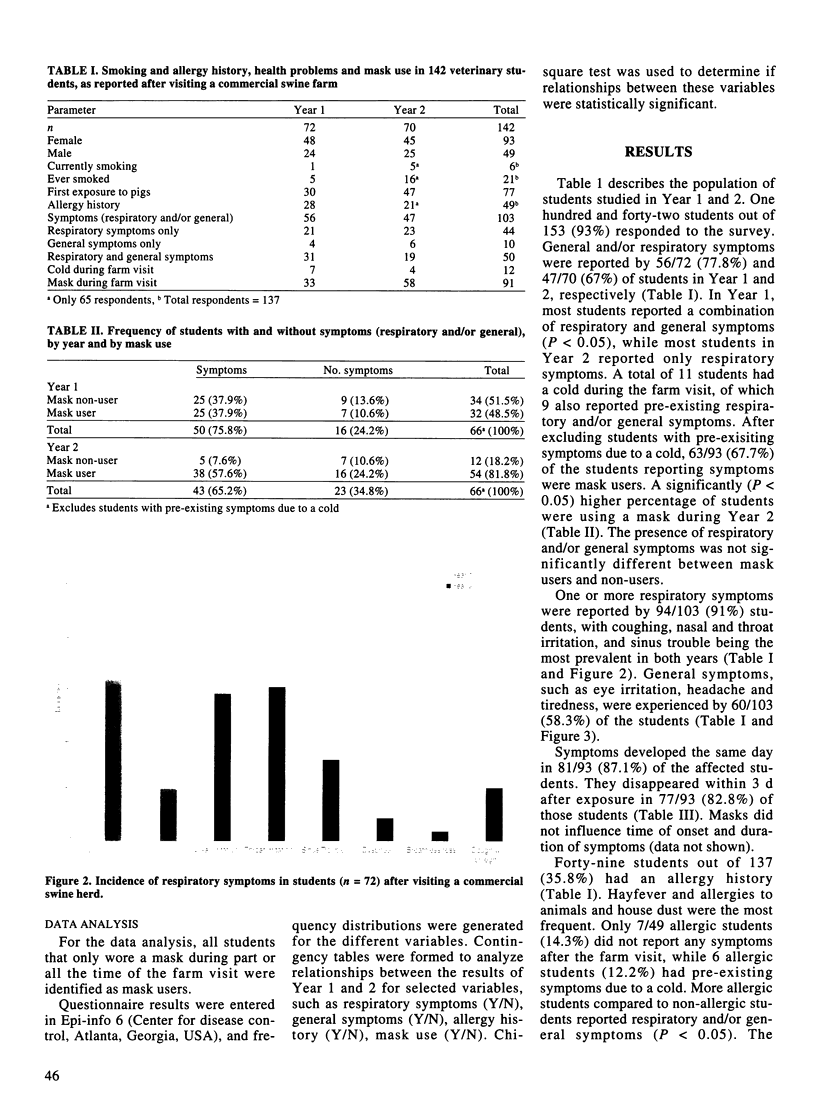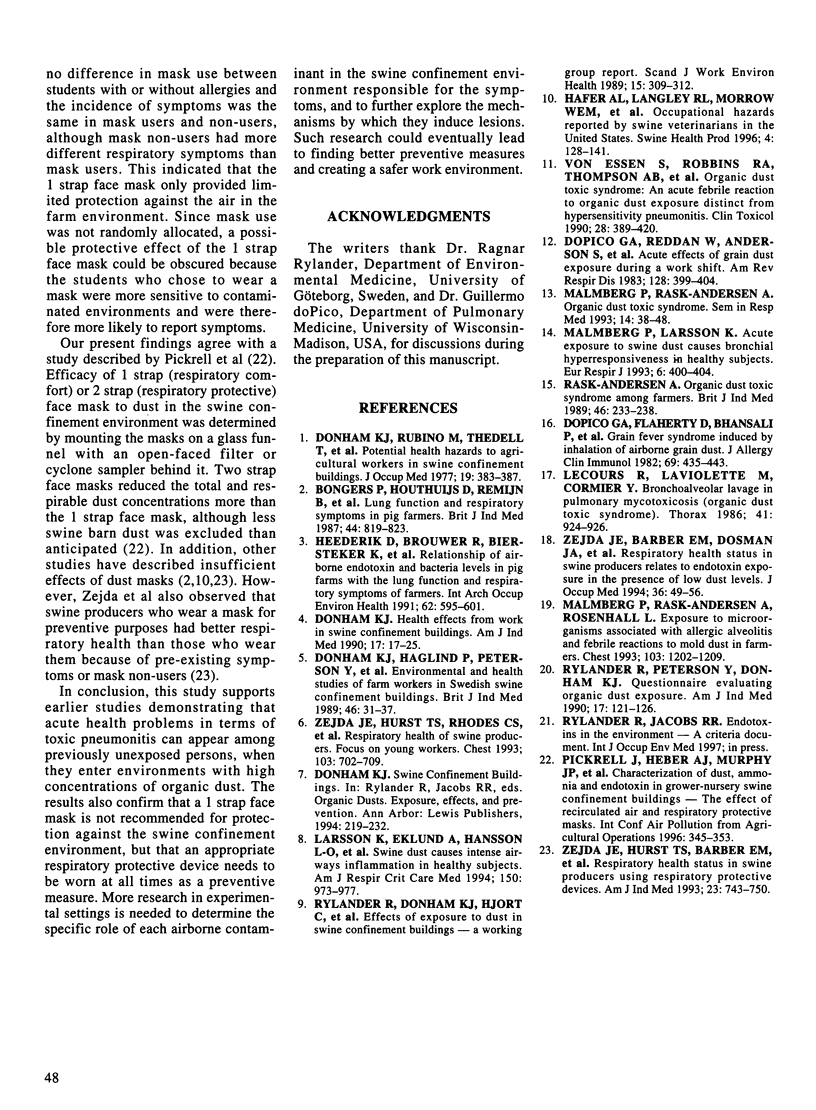Abstract
In October 1993 and 1994, respectively, 77 and 76 third-year veterinary students visited a swine farm to work with pigs for 3 h. On both occasions, a large number of students reported flu-like symptoms after the visit. To further investigate this, the students were presented with a questionnaire modeled after the standard questionnaire used for evaluating organic dust exposure. General and/or respiratory symptoms were reported by 103/142 (72.5%) students. General symptoms, such as eye irritation, headache and tiredness were experienced by 60/103 (42.2%) students. Cough, nasal and throat irritation, and sinus trouble were the most prevalent respiratory symptoms and were reported by 94/103 (91%) of the students. Symptoms mostly developed the same day and disappeared within 3 d after exposure. The presence of respiratory and/or general symptoms was not significantly different between students who wore a mask during the lab or those who did not. Students with pre-existing allergies were more likely to develop respiratory symptoms than non-allergic students.
Full text
PDF




Images in this article
Selected References
These references are in PubMed. This may not be the complete list of references from this article.
- Bongers P., Houthuijs D., Remijn B., Brouwer R., Biersteker K. Lung function and respiratory symptoms in pig farmers. Br J Ind Med. 1987 Dec;44(12):819–823. doi: 10.1136/oem.44.12.819. [DOI] [PMC free article] [PubMed] [Google Scholar]
- Donham K. J. Health effects from work in swine confinement buildings. Am J Ind Med. 1990;17(1):17–25. doi: 10.1002/ajim.4700170105. [DOI] [PubMed] [Google Scholar]
- Donham K. J., Rubino M., Thedell T. D., Kammermeyer J. Potential health hazards to agricultural workers in swine confinement buildings. J Occup Med. 1977 Jun;19(6):383–387. doi: 10.1097/00043764-197706000-00004. [DOI] [PubMed] [Google Scholar]
- Donham K., Haglind P., Peterson Y., Rylander R., Belin L. Environmental and health studies of farm workers in Swedish swine confinement buildings. Br J Ind Med. 1989 Jan;46(1):31–37. doi: 10.1136/oem.46.1.31. [DOI] [PMC free article] [PubMed] [Google Scholar]
- Heederik D., Brouwer R., Biersteker K., Boleij J. S. Relationship of airborne endotoxin and bacteria levels in pig farms with the lung function and respiratory symptoms of farmers. Int Arch Occup Environ Health. 1991;62(8):595–601. doi: 10.1007/BF00381114. [DOI] [PubMed] [Google Scholar]
- Larsson K. A., Eklund A. G., Hansson L. O., Isaksson B. M., Malmberg P. O. Swine dust causes intense airways inflammation in healthy subjects. Am J Respir Crit Care Med. 1994 Oct;150(4):973–977. doi: 10.1164/ajrccm.150.4.7921472. [DOI] [PubMed] [Google Scholar]
- Lecours R., Laviolette M., Cormier Y. Bronchoalveolar lavage in pulmonary mycotoxicosis (organic dust toxic syndrome). Thorax. 1986 Dec;41(12):924–926. doi: 10.1136/thx.41.12.924. [DOI] [PMC free article] [PubMed] [Google Scholar]
- Malmberg P., Larsson K. Acute exposure to swine dust causes bronchial hyperresponsiveness in healthy subjects. Eur Respir J. 1993 Mar;6(3):400–404. [PubMed] [Google Scholar]
- Malmberg P., Rask-Andersen A., Rosenhall L. Exposure to microorganisms associated with allergic alveolitis and febrile reactions to mold dust in farmers. Chest. 1993 Apr;103(4):1202–1209. doi: 10.1378/chest.103.4.1202. [DOI] [PubMed] [Google Scholar]
- Rask-Andersen A. Organic dust toxic syndrome among farmers. Br J Ind Med. 1989 Apr;46(4):233–238. doi: 10.1136/oem.46.4.233. [DOI] [PMC free article] [PubMed] [Google Scholar]
- Rylander R., Donham K. J., Hjort C., Brouwer R., Heederik D. Effects of exposure to dust in swine confinement buildings--a working group report. Scand J Work Environ Health. 1989 Oct;15(5):309–312. doi: 10.5271/sjweh.1846. [DOI] [PubMed] [Google Scholar]
- Rylander R., Peterson Y., Donham K. J. Questionnaire evaluating organic dust exposure. Am J Ind Med. 1990;17(1):121–126. doi: 10.1002/ajim.4700170142. [DOI] [PubMed] [Google Scholar]
- Von Essen S., Robbins R. A., Thompson A. B., Rennard S. I. Organic dust toxic syndrome: an acute febrile reaction to organic dust exposure distinct from hypersensitivity pneumonitis. J Toxicol Clin Toxicol. 1990;28(4):389–420. doi: 10.3109/15563659009038584. [DOI] [PubMed] [Google Scholar]
- Zejda J. E., Barber E., Dosman J. A., Olenchock S. A., McDuffie H. H., Rhodes C., Hurst T. Respiratory health status in swine producers relates to endotoxin exposure in the presence of low dust levels. J Occup Med. 1994 Jan;36(1):49–56. [PubMed] [Google Scholar]
- Zejda J. E., Hurst T. S., Barber E. M., Rhodes C., Dosman J. A. Respiratory health status in swine producers using respiratory protective devices. Am J Ind Med. 1993 May;23(5):743–750. doi: 10.1002/ajim.4700230508. [DOI] [PubMed] [Google Scholar]
- Zejda J. E., Hurst T. S., Rhodes C. S., Barber E. M., McDuffie H. H., Dosman J. A. Respiratory health of swine producers. Focus on young workers. Chest. 1993 Mar;103(3):702–709. doi: 10.1378/chest.103.3.702. [DOI] [PubMed] [Google Scholar]
- doPico G. A., Flaherty D., Bhansali P., Chavaje N. Grain fever syndrome induced by inhalation of airborne grain dust. J Allergy Clin Immunol. 1982 May;69(5):435–443. doi: 10.1016/0091-6749(82)90118-x. [DOI] [PubMed] [Google Scholar]
- doPico G. A., Reddan W., Anderson S., Flaherty D., Smalley E. Acute effects of grain dust exposure during a work shift. Am Rev Respir Dis. 1983 Sep;128(3):399–404. doi: 10.1164/arrd.1983.128.3.399. [DOI] [PubMed] [Google Scholar]




